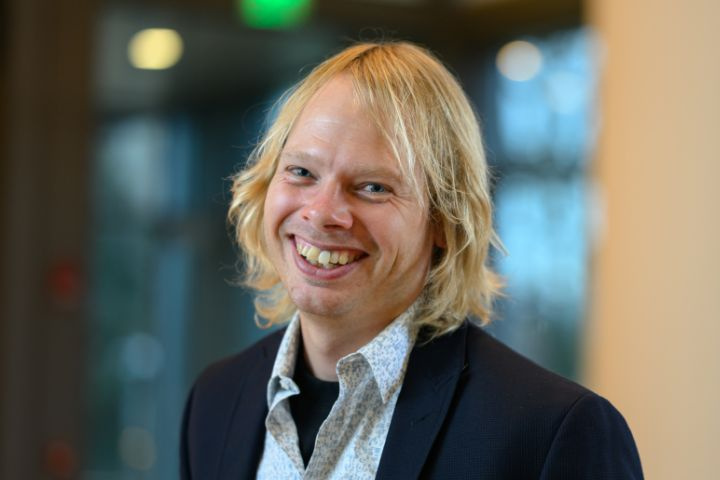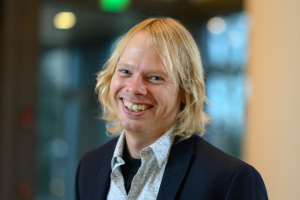3 Questions with Richard Nielsen: How political science helps combat terrorism
Assistant Professor Richard Nielsen explores why some Muslim clerics adopt the ideology of militant jihad while most do not.

"My own work has drawn heavily on a number of normally distant disciplines," says Richard Nielsen, MIT assistant professor of political science. "I’m convinced that ... despite the tendency for scholars to remain in our own disciplinary silos, the big breakthroughs on complex issues will come at the intersections of fields, from researchers and teams that are willing to bridge disciplinary divides." -Richard Nielsen
Photo: Stuart Darsch
Science and technology are essential tools for innovation, and to reap their full potential, we also need to articulate and solve the many aspects of today’s global issues that are rooted in the political, cultural, and economic realities of the human world. With that mission in mind, MIT's School of Humanities, Arts, and Social Sciences has launched "The Human Factor" — an ongoing series of stories and interviews that highlight research on the human dimensions of global challenges. As the editors of the journal Nature have said, framing such questions effectively — incorporating all factors that influence the issue — is a key to generating successful solutions. Contributors to this series also share ideas for advancing the multidisciplinary collaborations needed to solve the major global issues.
Richard Nielsen is an MIT assistant professor of political science who writes on international law, the political economy of human rights, political violence, and political methodology. His current book project, Deadly Clerics, explores why some Muslim clerics adopt the ideology of militant jihad while most do not.
Q: War and terrorist activity pose significant threats both to human health and to the health of the planet. What can political science scholarship contribute to addressing these threats?
A: It is very easy to believe that the world is becoming a more dangerous, violent place, but data on the incidence of violence throughout human history collected by Steven Pinker, as well as by Bethany Lacina, Nils Gleditsch, and Bruce Russett, show that the odds of dying violently are lower now than they’ve ever been. This isn’t to say that terrorism isn’t a problem, but we should keep the true level of threat posed by terrorism in perspective.
Counterterrorism policies can have serious unintended consequences. For example, some of my own research shows that drone strikes against jihadist preachers makes their ideas more popular. Others have raised the concern that drone strikes might fuel terrorism by adding to the grievances of the vulnerable populations in which terrorists circulate.
As humans, we have all sorts of cognitive biases that come into play when we try to evaluate the risks posed by terrorism as well as the trade-offs of various counterterrorism policies. Political science and other data-oriented disciplines offer an alternative to bias-based decisions, enabling leaders to make more effective policies and avoid a “cure” that is worse than the disease.
Q: Within the field of political science, what areas of scholarship do you think most need to be investigated to encourage progress toward greater geopolitical stability?
A: There have been thousands of books and articles on the topic of violent jihad in the last 15 years, but we still don’t know everything we’d like to about how to counter this global threat. To cite an example from my own specialty, it's interesting that in all this time, no one has (to my knowledge) produced a credible, open-source estimate of the proportion of Muslim clerics online who are preaching miliant jihad.
In my forthcoming book, Deadly Clerics, I use a new approach, informed by methods from computer science, to put forth an estimate that about 10 percent of Muslim clerics on the Internet are jihadists. I don’t know if this number should strike readers as high or low; it’s higher than I expected. The point is that now that we know, we can start thinking about what this means for the civil war that’s taking place for the soul of Islam right now.
This points to the more general question of how the internet is affecting international relations. Some great work has been done on this topic by my MIT colleague Nazli Choucri, who investigates the sources and consequences of international conflict and violence, but more research is needed as all signs suggest that the internet is going to matter even more in the future.
Therefore, the question I’m starting to tackle now is: How is the internet changing the nature of religious authority in Islam? The problem of modern jihadism is rooted in an ongoing crisis of Islamic authority brought about by the rise of media — first print, then cassette tapes, and now the online Fatwa Bank. My hope is that studying the politics of Islamic authority online will shed light on the more general question of how the internet is empowering individuals to shape international affairs to a degree that simply wasn’t possible before the Information Age.
Q: As MIT President L. Rafael Reif has said, solving the great challenges of our time will require multidisciplinary problem-solving — bringing together expertise from science, technology, the social sciences, arts, and humanities. Can you share comment on the barriers to such multidisciplinary collaborations, and how can we overcome them?
A: My own work on violent jihadism has drawn heavily on a number of normally distant disciplines: statistics, Arabic, computer science, computational linguistics, anthropology, and Islamic studies. I’ve reached new insights as a result, and I’m convinced that despite the tendency for scholars to remain trapped in our own disciplinary silos, the big breakthroughs on complex issues will come at the intersections of fields, from researchers and teams that are willing to bridge disciplinary divides.
Bridging disciplines is difficult, however, and I’ve got personal experience with a few of the challenges that researchers face in doing so. I see the biggest obstacles as practical — differences in the funding of different disciplines, and strong incentives created by the academic promotion process to do disciplinary, rather than interdisciplinary work.
The issue of funding is particularly tricky. In collaborations with researchers in science, technology, engineering, and math (STEM) fields, they are often surprised that political science faculty (and graduate students) are rarely funded by grants. In fact, this is because there are just fewer grant dollars for political scientists. In 2015, the National Science Foundation allocated over $1 billion in math and computer science grants; it also gave out approximately $900 million in grants each to both physical sciences and engineering.
Contrast that $3 billion with the $180 million allocated for social and behavioral sciences, of which political science got a meager $11 million. This means that I’ve often been in the uncomfortable position of not being able to bring in funding for a proposed joint project with STEM researchers — with the result that the project languished.
The other barrier I’ve had to personally surmount is the lack of shared language between disciplines. Insights from one field can be lost on researchers in another because of terminology differences, incompatible standards of evidence, and sometimes, a simple lack of respect for modes of inquiry in other fields.
I’m not the first to point out these problems, and I sadly won’t be the last, but MIT is making strides in bridging the gaps. I’m part of the new Institute for Data, Systems, and Society, which is explicitly trying to bring engineers and social scientists together to address complex societal issues. So far, it’s been a tremendous success, made possible by the vision of the Institute's leaders and the willingness of the MIT community to make it work.

